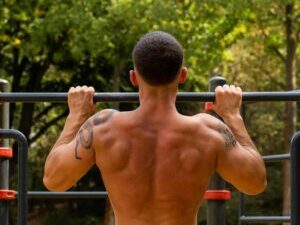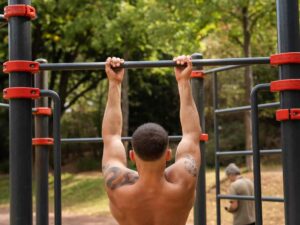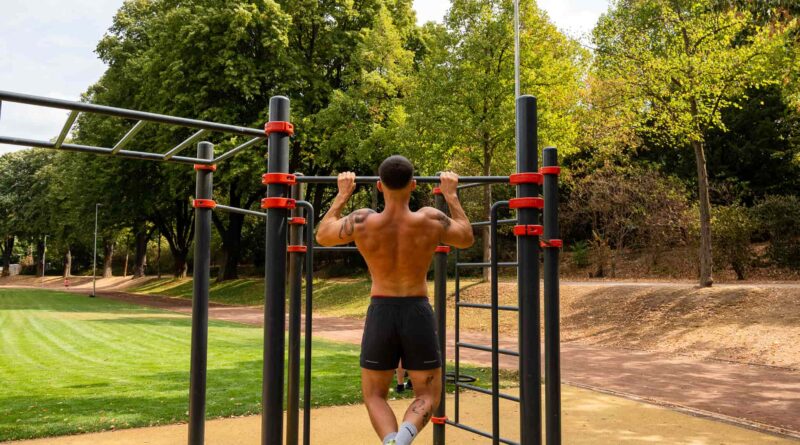Pull-ups – Insights and tips
Everyone who is a little bit involved in sports knows about pull-ups. The pull-up is a great exercise that targets a lot of muscles. For some, the pull-up is an easy task and they need a new and harder challenge. For the other(s) the challenge is to first create a free pull-up. In this article we try to give added value to everyone and show you both easy and hard versions of the pull-up.
Contents
What are pull-ups and how are they performed?
To perform pull-ups, you need, in the best case, a fixed bar installed horizontally to the floor. If possible, the bar should be high enough so that your legs can remain extended when you hang from the bar. Alternatively, a pull-up can be performed on gymnastic rings or a climbing wall. There is no distinction between pull up (pronated grip) and chin up (supinated grip) in German. To perform a pull-up, you normally pull yourself up without gaining momentum until your chin is above the anchor point of your hands.
Which muscle groups are targeted during the pull-up?
The pull-up is an effective exercise for strengthening various muscle groups in the upper body. The primary muscles used in the pull-up are the back muscles. These include the latissimus dorsi (the broadest back muscle), the rhomboid major and minor (the lower back muscles) and the trapezius (the shoulder blade muscle). In addition to the back muscles, the abdominal muscles, the chest muscles, the shoulders and the arm muscles are also involved in the pull-up. The chin-up is so effective because it works the entire upper body. Depending on the variation of the grip, the specific relative load on the individual muscle groups changes. A pull-up with a supinated grip usually results in a higher activation of the biceps.
The many advantages of chin-up training
Pull-ups are one of the most effective exercises you can do to strengthen your upper body muscles. So why should you do pull-ups?
Well, there are several reasons.
Firstly, pull-ups are a very functional exercise.
That is, they target the muscles you use most in your daily life. So if you want to have strong upper arm and back muscles, pull-up training is ideal for you.
Secondly, pull-ups offer an improvement in physical condition
A well-rounded strength training programme to improve joint function, bone density, muscle, tendon and ligament strength.
Thirdly, pull-ups are a great way to get your body in shape.
If you exercise regularly, you will quickly notice that you have more strength and endurance and feel better in general. For many people, pull-up training is also a great way to relieve stress. The physical exertion releases endorphins, which leads to a feeling of satisfaction and relaxation. So if you are looking for an effective way to strengthen your upper body muscles and stay fit at the same time, pull-ups are for you!
Beginner tips for pull-ups
If you’re not yet able to perform a pull-up completely, that doesn’t mean you have to throw in the towel. There are a few ways you can approach your first perfectly executed pull-up.
- Get momentum
A properly executed pull-up works from a steady hang so that the exercise is performed with maximum intensity. If you can’t do this yet, there’s no shame in it. Take some momentum with your legs and use the momentum to pull yourself up more easily on the bar. If you do this often enough, you will develop the strength you need to one day perform the chin-up from the steady slope.
- Practice on a low bar
Imagine the bar is placed high enough for you to reach while standing so that its arms are slightly bent. Now you can easily push off with your feet and do the rest of the pull-up under your own power. In this way you can practise the second part of the pull-up as a beginner, provided your goal is to eventually pull your pull-ups up over your chin.
- Practise with a training partner
If you have the opportunity to practice with a training partner, you can also help each other to complete a pull-up. It is best to grab your partner’s hip and make sure that you only help as much as is necessary so that your partner can just manage the pull-up. This will give you the best training effect.
Advanced tips
The tips for advanced users are logically quite contrary to the tips for beginners.
- Perform cleanly and slowly
Be meticulous about not taking any momentum and perform the pull-up purely from a steady incline. This will ensure that you get the maximum effect.
- Feet should not be in contact with the floor
The bar should be high enough so that you can hang completely stretched out on it to be able to perform the exercise completely.
Once you have mastered the pull-up freely and without swinging, you can start to incorporate different variations into your training. You can also increase the intensity of the workout by changing various parameters. You can change the number of repetitions, perform the exercise more slowly or add an extra weight. We have written an article for you on training intensity and RPE.
Regular challenges, such as beating the maximum number of pull-ups you can perform in one go, can help track your progress and keep you motivated.
Get creative and find ways to help you stay motivated.
Different variations of pull-ups
Pull-ups can be varied by changing the type of grip or the grip width. The pull-up always targets a variety of muscle groups. The variations merely set different emphases, but never train muscles in isolation.


The normal pull-up (pronated)
Grasp the bar with the palms facing away from the body. The hands are shoulder width apart.
The comb grip pull-up (supinated)
Grasp the bar with the palms facing the body. The hands are shoulder-width apart.
The Twin Grip Pull-Up
In the double grip one hand points away from the body and one hand towards the body before grasping the bar. Arms are again shoulder-width apart. Make sure you do this evenly. This means that if the left hand is facing away from the body and the right hand is facing towards the body on the first pass, you should then grasp the bar in the opposite direction on the next pass.
Different grip widths
You can also experiment with different grip widths. Normally you grip the bar about shoulder width. Try gripping the bar a little narrower or wider. You will notice that you are challenged differently than before.
L-hang pull-ups
Now we deviate from our basic rule that the legs should be extended. You now hang from the bar with your arms outstretched and lift your legs so that your hips are at a 90° angle to your torso and legs. Hold this position of the legs throughout the exercise.
Myth – The one-arm pull-up
There are reports of people being able to do one-arm pull-ups. But is this really possible or is it just a myth? Yes, it is indeed possible. However, there are very few people who can really do one-arm pull-ups. Most of them are very experienced climbers.
We will write an explicit training plan for a one-arm pull-up in the future!
Conclusion
Pull-ups are one of the most effective and versatile exercises you can do. You train the whole body and they are ideal for beginners and advanced. So if you’re looking for an exercise that will help you get your body in top shape, then you should definitely start doing pull-ups!

